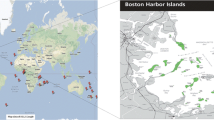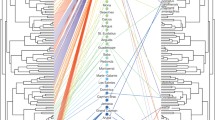Abstract
For one large community that I know well, I will discuss those aspects of the component species’ life history or other ecological characteristics that determine whether they are good island colonists. Three broad questions will serve to focus the discussion:
-
(1)
What traits and forces allow good colonists to be good colonists?
-
(2)
Do any taxonomic or other patterns unify the set of good colonists?
-
(3)
Are there rules or patterns describing which island colonists are found together?
Access this chapter
Tax calculation will be finalised at checkout
Purchases are for personal use only
Preview
Unable to display preview. Download preview PDF.
Similar content being viewed by others
References
Abbott, I.: Species richness, turnover, and equilibrium in insular floras near Perth, Western Australia. Aust. J. Bot. 25, 193–208 (1977).
Abbott, I., Abbott, L. K., Grant, P. R.: Comparative ecology of Galapagos ground finches (Geospiza Gould): Evaluation of the importance of floristic diversity and interspecific competition. Ecol. Monogr. 47, 151–184 (1977).
Brown, J. H., Kodric-Brown, A.: Turnover rates in insular biogeography: Effects of immigration on extinction. Ecology 58, 445–449 (1977).
Connor, E. F., Simberloff, D.: The assembly of species communities: Chance or competition? Ecology 60, 1132–1140(1979).
Diamond, J. M.: Assembly of species communities. In: Ecology and Evolution of Communities. Cody, M. L., Diamond, J. M. (eds.). Cambridge, Mass.: Harvard Univ. Press, 1975, pp. 342–444.
Grant, P. R.: Colonization of islands by ecologically dissimilar species of mammals. Can. J. Zool. 48, 545–553 (1970).
Heatwole, H., Levins, R.: Trophic structure stability and faunal change during recolo- nization. Ecology 53, 531–534 (1972).
King, C. M., Moors, J. P.: On co-existence, foraging strategy and the biogeography of weasels and stoats Mustek nivalis and M. erminea) in Britain. Oecologia 39, 129–150 (1979).
Lewontin, R. C.: Selection for colonizing ability. In: The Genetics of Colonizing Species. Baker, H. G., Stebbins, G. L. (eds.). New York: Academic Press, 1965, pp. 77–94.
Pianka, E. R.: On r and K selection. Am. Nat. 104, 592–597 (1970).
Pianka, E. R.: Evolutionary Ecology, 2nd ed. New York: Harper and Row, 1978.
Pielou, D. P., Pielou, E. C.: Association among species of infrequent occurrence: The insect and spider fauna ofPolyporus betulinus (Bulliard) Fries. J. Theor. Biol. 21, 202–216 (1968).
Simberloff, D.: Experimental zoogeography of islands: A model for insular colonization. Ecology 50, 296–314 (1969).
Simberloff, D.: Trophic structure determination and equilibrium in an arthropod community. Ecology 57, 395–398 (1976a).
Simberloff, D.: Species turnover and equilibrium island biogeography. Science 194, 572–578 (1976b).
Simberloff, Experimental zoogeography of islands: Effects of island size. Ecology 57, 629–648 (1976c).
Simberloff, D.: Using island biogeographic distributions to determine if colonization is stochastic. Am. Nat. 112, 713–726 (1978a).
Simberloff, D. S.: Colonisation of islands by insects: Immigration, extinction, and diversity. In: Diversity of Insect Faunas, Mound, L. A., Waloff, N. (eds.). Oxford: Blackwell Scientific Publ., 1978b, pp. 139–153.
Simberloff, D., Boecklen, W.: Santa Rosalia reconsidered: Size ratios and competition. Evolution (1981) (in press).
Simberloff, D., Connor, E.F.: Missing species combinations. Am. Nat. (1981) (in press).
Simberloff, D., Wilson, E. O.: Experimental zoogeography of islands: The colonization of empty islands. Ecology 50, 278–296 (1969).
Simberloff, D., Wilson, E. O.: Experimental zoogeography of islands: A two-year record of colonization. Ecology 51, 934–937 (1970).
Strong, D. R., Jr., Szyska, L. A., Simberloff, D.: Tests of community-wide character displacement against null hypotheses. Evolution 33, 897–913 (1979).
Wilson, E. O., Simberloff, D.: Experimental zoogeography of islands: Defaunation and monitoring techniques. Ecology 50, 267–278 (1969).
Editor information
Editors and Affiliations
Rights and permissions
Copyright information
© 1981 Springer-Verlag New York Inc.
About this paper
Cite this paper
Simberloff, D. (1981). What Makes a Good Island Colonist?. In: Denno, R.F., Dingle, H. (eds) Insect Life History Patterns. Proceedings in Life Sciences. Springer, New York, NY. https://doi.org/10.1007/978-1-4612-5941-1_12
Download citation
DOI: https://doi.org/10.1007/978-1-4612-5941-1_12
Publisher Name: Springer, New York, NY
Print ISBN: 978-1-4612-5943-5
Online ISBN: 978-1-4612-5941-1
eBook Packages: Springer Book Archive




